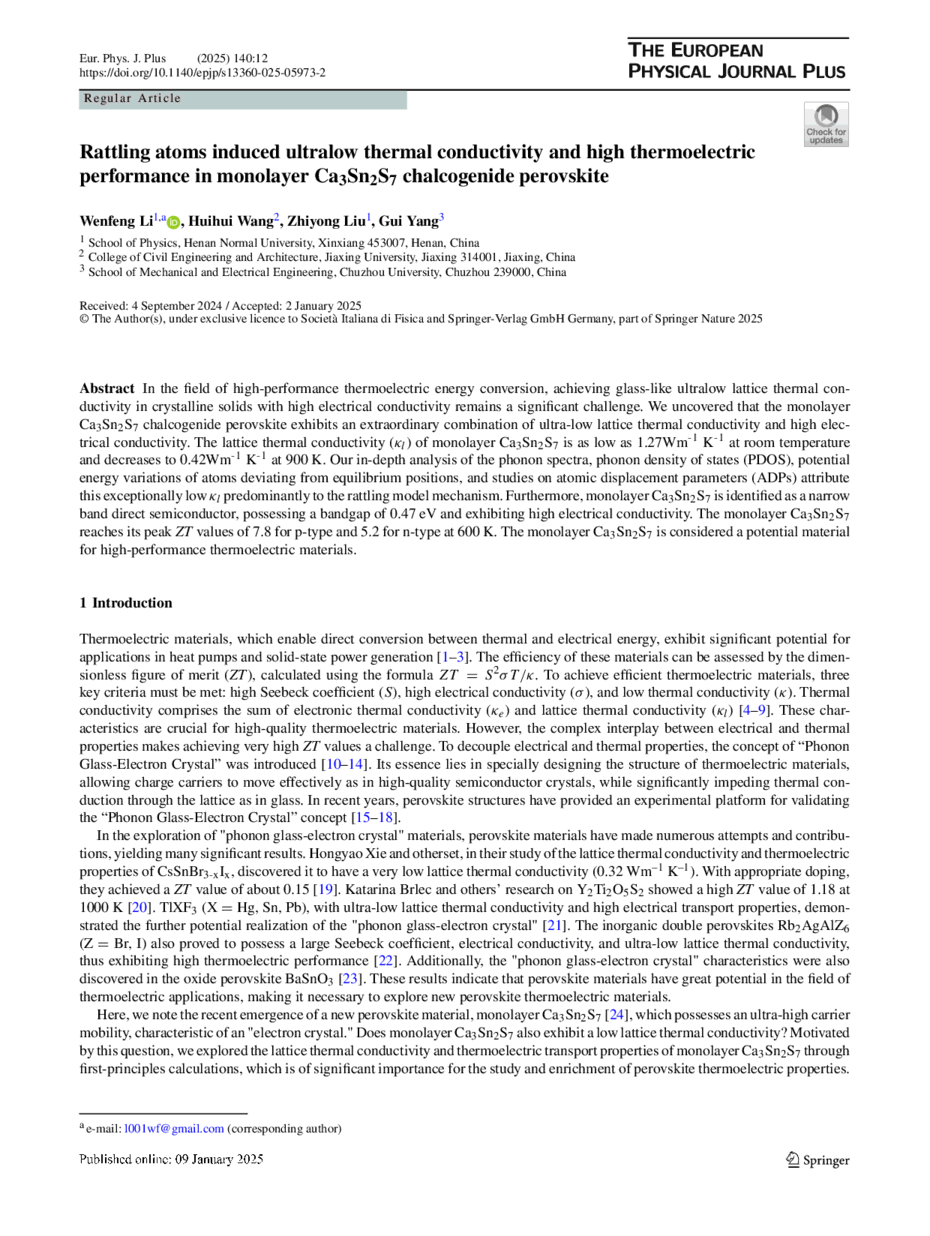https://doi.org/10.1140/epjp/s13360-025-05973-2
Regular Article
Rattling atoms induced ultralow thermal conductivity and high thermoelectric performance in monolayer Ca3Sn2S7 chalcogenide perovskite
1
School of Physics, Henan Normal University, 453007, Xinxiang, Henan, China
2
College of Civil Engineering and Architecture, Jiaxing University, 314001, Jiaxing, Jiaxing, China
3
School of Mechanical and Electrical Engineering, Chuzhou University, 239000, Chuzhou, China
Received:
4
September
2024
Accepted:
2
January
2025
Published online:
9
January
2025
In the field of high-performance thermoelectric energy conversion, achieving glass-like ultralow lattice thermal conductivity in crystalline solids with high electrical conductivity remains a significant challenge. We uncovered that the monolayer Ca3Sn2S7 chalcogenide perovskite exhibits an extraordinary combination of ultra-low lattice thermal conductivity and high electrical conductivity. The lattice thermal conductivity ( ) of monolayer Ca3Sn2S7 is as low as 1.27Wm⁻1 K⁻1 at room temperature and decreases to 0.42Wm⁻1 K⁻1 at 900 K. Our in-depth analysis of the phonon spectra, phonon density of states (PDOS), potential energy variations of atoms deviating from equilibrium positions, and studies on atomic displacement parameters (ADPs) attribute this exceptionally low
) of monolayer Ca3Sn2S7 is as low as 1.27Wm⁻1 K⁻1 at room temperature and decreases to 0.42Wm⁻1 K⁻1 at 900 K. Our in-depth analysis of the phonon spectra, phonon density of states (PDOS), potential energy variations of atoms deviating from equilibrium positions, and studies on atomic displacement parameters (ADPs) attribute this exceptionally low  predominantly to the rattling model mechanism. Furthermore, monolayer Ca3Sn2S7 is identified as a narrow band direct semiconductor, possessing a bandgap of 0.47 eV and exhibiting high electrical conductivity. The monolayer Ca3Sn2S7 reaches its peak ZT values of 7.8 for p-type and 5.2 for n-type at 600 K. The monolayer Ca3Sn2S7 is considered a potential material for high-performance thermoelectric materials.
predominantly to the rattling model mechanism. Furthermore, monolayer Ca3Sn2S7 is identified as a narrow band direct semiconductor, possessing a bandgap of 0.47 eV and exhibiting high electrical conductivity. The monolayer Ca3Sn2S7 reaches its peak ZT values of 7.8 for p-type and 5.2 for n-type at 600 K. The monolayer Ca3Sn2S7 is considered a potential material for high-performance thermoelectric materials.
Copyright comment Springer Nature or its licensor (e.g. a society or other partner) holds exclusive rights to this article under a publishing agreement with the author(s) or other rightsholder(s); author self-archiving of the accepted manuscript version of this article is solely governed by the terms of such publishing agreement and applicable law.
© The Author(s), under exclusive licence to Società Italiana di Fisica and Springer-Verlag GmbH Germany, part of Springer Nature 2025
Springer Nature or its licensor (e.g. a society or other partner) holds exclusive rights to this article under a publishing agreement with the author(s) or other rightsholder(s); author self-archiving of the accepted manuscript version of this article is solely governed by the terms of such publishing agreement and applicable law.





